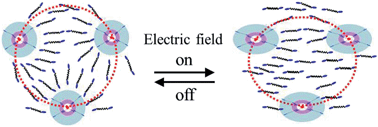Optically isotropic liquid crystal media formulated by doping star-shaped cyclic oligosiloxane liquid crystal surfactants in twin nematic liquid crystals†
Abstract
The formation of optically isotropic liquid crystal (LC) media has been investigated by doping the star-shaped LC molecular surfactants (SiLC) into the rod-shaped twin LC host molecules (DiLC). The experimental phase diagram was constructed on the basis of differential scanning calorimetry (DSC) and then a theoretical calculation was conducted through a combined Flory–Huggins (FH)/Maier–Saupe–McMillan (MSM)/phase field (PF) model to account for the experimental results. The phase diagram of the SiLC/DiLC mixtures revealed the broad coexistence regions such as smectic A + crystal (SmA1 + Cr2), liquid + crystal (L1 + Cr2), and liquid + nematic (L1 + N2) at the intermediate composition along with the narrow single phase crystal (Cr2), smectic (SmA1), and nematic (N2) regions. The morphologies and structures of these coexistence regions were further confirmed by polarized optical microscopy (POM) and wide-angle X-ray diffraction (WAXD). At the 80/20 SiLC/DiLC composition, the optical anisotropy was induced under an alternating current (AC) electric field above its isotropization temperature. The formation of an optically isotropic LC medium in mixtures of the SiLC molecular surfactants and nematic LC host may allow us to develop new electro-optical devices.


 Please wait while we load your content...
Please wait while we load your content...